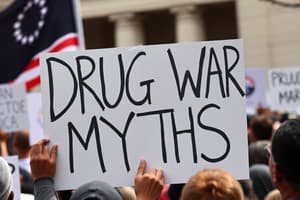Podcast
Questions and Answers
What was southern redemption?
What was southern redemption?
Fierce response to the Reconstruction period aimed at reducing power, literacy, and civil rights.
What were convict leasing laws and how were they worse than slavery?
What were convict leasing laws and how were they worse than slavery?
They were essentially slavery; conditions were much worse than slavery as landowners did not invest in keeping leased convicts alive.
How and why did desegregation arise, and what were the Jim Crow laws?
How and why did desegregation arise, and what were the Jim Crow laws?
Desegregation arose to challenge legal forced segregation like 'separate but equal', enforced by Jim Crow laws.
What happened with Brown v. Board of Education in 1954?
What happened with Brown v. Board of Education in 1954?
What did the civil rights movement accomplish, specifically regarding the Civil Rights Act of 1964 and Voting Rights Act of 1965?
What did the civil rights movement accomplish, specifically regarding the Civil Rights Act of 1964 and Voting Rights Act of 1965?
What were the Poor People's Movements, Lyndon B. Johnson's War on Poverty, and the Economic Opportunity Bill of 1964?
What were the Poor People's Movements, Lyndon B. Johnson's War on Poverty, and the Economic Opportunity Bill of 1964?
Flashcards are hidden until you start studying
Study Notes
Southern Redemption
- Reaction to the Reconstruction era characterized by anger and resistance.
- Aimed to diminish the power and rights of African Americans, including literacy and civil rights.
Convict Leasing Laws
- System that enslaved black individuals by criminalizing everyday activities, leading to imprisonment and forced labor for landowners.
- Conditions in leasing were often harsher than those experienced during slavery, as landowners neglected the health and well-being of the leased workers.
- Integral to the process of Southern redemption.
Jim Crow Laws and Desegregation
- Enforced legal segregation that prevented African Americans from using public facilities such as bathrooms, buses, and schools.
- Founded on the principle of "separate but equal," which was a rationalization for continued racial discrimination.
Brown v. Board of Education (1954)
- Landmark Supreme Court case that declared state laws establishing separate public schools for black and white students unconstitutional.
- Marked a significant legal victory for the desegregation movement, challenging the validity of "separate but equal."
Civil Rights Movement Achievements
- Led to the Civil Rights Act of 1964, prohibiting racial discrimination in public places and employment.
- Resulted in the Voting Rights Act of 1965, aimed at eliminating barriers to voting for African Americans.
- Southern resistance included numerous protests, highlighting the struggle for desegregation.
Poor People's Movement and War on Poverty
- Initiated by Martin Luther King Jr. to advocate for economic justice across racial lines, uniting black and white individuals.
- Lyndon B. Johnson's War on Poverty aimed at alleviating poverty through the Economic Opportunity Bill of 1964.
- Focused on anti-poverty reform to address socio-economic inequalities in the United States.
Studying That Suits You
Use AI to generate personalized quizzes and flashcards to suit your learning preferences.




